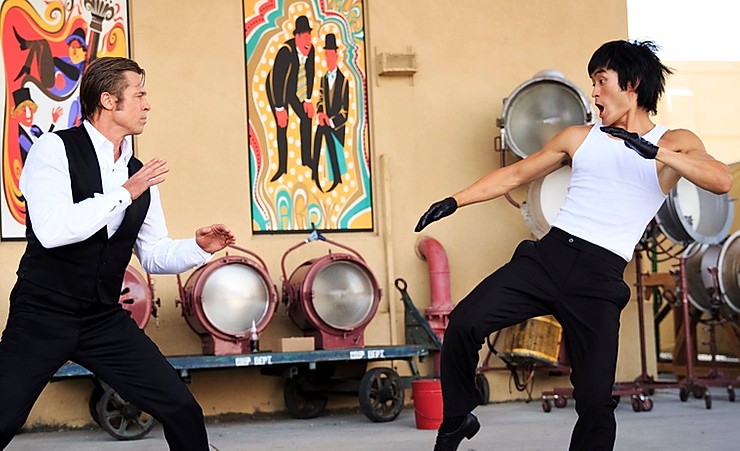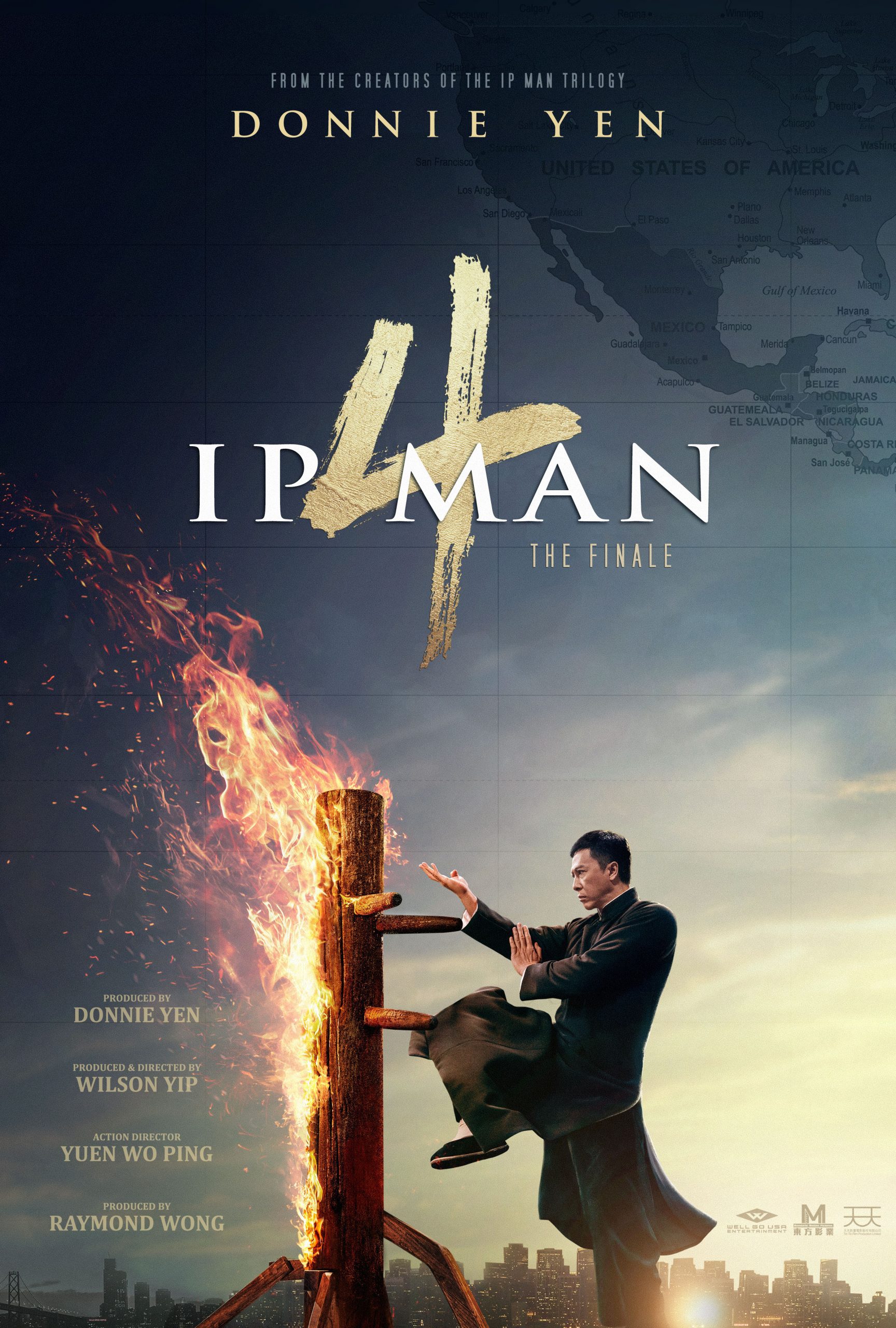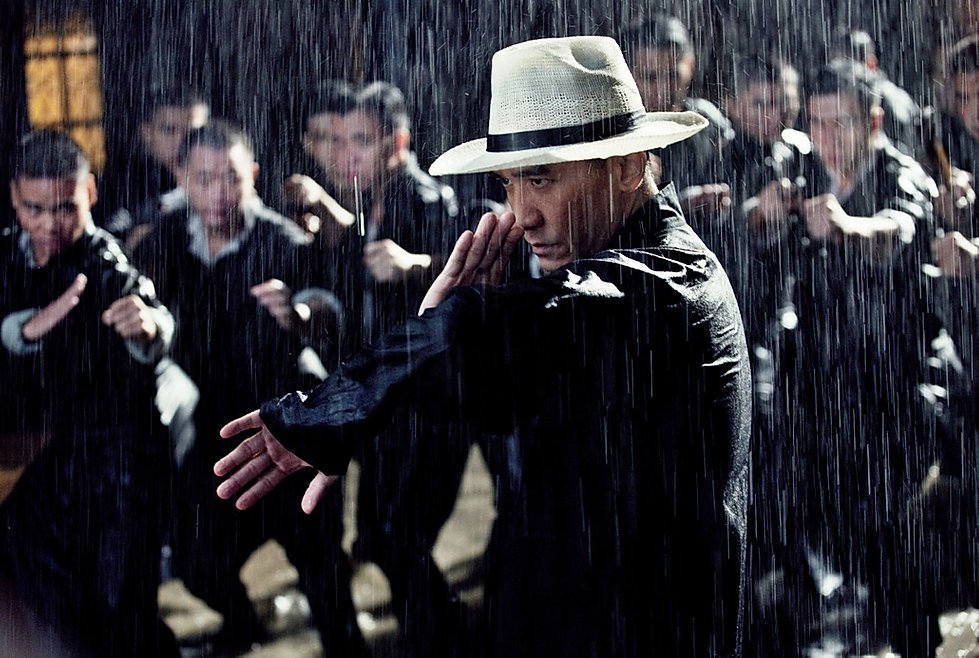A fight scene between Brad Pitt’s character, Cliff, and Bruce Lee, played by Mike Moh, has enraged many people in the Martial Arts community. The scene has been criticised as disrespectful and an example of racist stereotypes. Lee’s daughter, Shannon Lee made this public statement: “While I understand that the mechanism in the story is to make Brad Pitt’s character out to be such a badass that he can beat up Bruce Lee, the script treatment of my father as this arrogant, egotistical punching bag was really disheartening – and, I feel, unnecessary.” It’s true. Bruce is a little arrogant in the film. But I wonder if the bigger issue is that Bruce Lee is portrayed as a mere mortal. In the years since his death, Bruce Lee has been elevated to a legendary figure capable of killing any man by merely staring at him. He’s not the only one. Kung Fu is filled with stories of legendary Masters who had hundreds of fights and were never defeated. These stories though, are often told by students of said Masters, with little or no corroborating evidence. They must be taken with a grain of salt. In fact, after more than 20 years of experience in Kung Fu circles, my personal opinion is that they should be taken with a grain of salt, a slice of lime, and a shot of tequila – so far fetched some of these stories are. The question that angers so many in the Kung Fu community and might be at the heart of this criticism of Tarantino’s film is – was Bruce Lee as good a fighter as his legend suggests? Truthfully, we have no way of knowing. He was not a professional fighter and we have no footage of any real fights he was involved in. There is no question the man was a pioneer and a supremely gifted athlete with incredible speed. He was one of the first to introduce the idea of Mixed Martial Arts. Taking bits and pieces from different Arts to make himself a more rounded Martial Artist. But he was an actor. Not a professional fighter. How would he stack up against modern day MMA warriors like Conor McGregor or Khabib Nurmagomedov? It is almost a forbidden question in Kung Fu circles, but let’s be real. Could a part-time tennis player defeat Roger Federer? Of course not. So why do we think that a part-time, non-professional Martial Artist could defeat the best of the best? We saw with Ronda Rousey, how quickly the MMA game evolves and leaves people behind. Truthfully, in a fight against someone like Conor or Khabib, Bruce Lee would probably be convincingly defeated. But that doesn’t take away from the genius of the man. His fighting philosophy, raw athleticism and training discipline were incredible. Had he been born in modern times and trained as an MMA fighter, I have no doubt he would have been one of the best. He was an exceptional individual, and that should be enough. 0 Facebook 0 Twitter 0 Linkedin 0 Pinterest 0 Viber 0 Whatsapp 0 Telegram 0 Email
Ip Man 4 – End of an Era
This is it! Donnie Yen will play Ip Man for the last time when Ip Man 4 hits cinemas in Hong Kong, Taiwan and China on December 20, 2019. The Ip Man series started in 2008 and has grossed $228 million at the box office, with Ip Man 2 and 3 being released in 2010 and 2016 respectively. Ip Man 3, which famously starred “Hall of Fame” Boxer Mike Tyson, earned 157 million USD at the box office, making it the most successful of the series. Donnie Yen himself confirmed this will be the final instalment in the series when he posted on his Instagram account the following message: “Thank you all for many years of love and support for this incredible journey! This December 20, my fourth saga and the final!” Ip Man 4 sees Ip Man arriving in the United States during the Vietnam war in 1964, and will cover the early days of Bruce Lee in America. Lee opens a Wing Chun school in San Francisco, which upsets the other local martial artists. The new villain will be played by British martial arts star, Scott Adkins and Bruce Lee will be played by Hong Kong actor, Danny Chan, who also played Lee in Ip Man 3. It has been a great time to be a Wing Chun practitioner. Our beloved Art has never been so popular, with the Ip Man series inspiring a wave of new practitioners. Though the movies have often mixed fact with fiction, they often depict Ip Man as a humble man who tries to help out the community. This is perhaps the greatest achievement of the series. Beyond the amazing choreography and technical capability of Mr Donnie Yen, who comes across as a more than credible Wing Chun Master, the series has a big heart and emphasises the need for great responsibility that comes with great power. We certainly need more of this in today’s world. This might be the final instalment, but the series will live forever in Cinema history and just as importantly, in Wing Chun history. Thank you for the ride Donnie. You have portrayed Ip Man with honour and dignity. The Wing Chun community is forever in your debt. 0 Facebook 0 Twitter 0 Linkedin 0 Pinterest 0 Viber 0 Whatsapp 0 Telegram 0 Email
Becoming a Wing Chun Master
How Long will you take to Master Wing Chun? The key to mastery in any field is persistence. Malcolm Gladwell stated that 10,000 hours of practice are required to become world class in any field. Of course, this theory fails to discriminate between the quantity of hours spent practicing, and the quality of that practice. The 10,000 rule is an oversimplification. Genetics, age and how you practice all play a part in how long it will take you to become a master. However, oversimplifications are all we have when we are trying to answer a question like this. With the 10,000 hour rule, if we give ourselves a 10 year time line to Master Wing Chun, we need to practice 2.7 hours a day, every day. But that is in order to become “world class”. What if we just want to become good enough to teach Wing Chun? From my own experience in learning Martial Arts and Musical instruments, I believe 5 hours a week over 5 years is plenty to become good at something. Not world class, but very, very good. That’s probably the standard most people are aiming for, to be fair. When I taught myself how to play guitar, I wasn’t aiming at being the next Eric Clapton, I just wanted to be able to play my favourite tunes well. Sifu Derek Fung, who was a disciple of Ip Man, mentioned to us when we interviewed him that with intensive training you can learn the system in 4 years. So, let’s set 5 hours a week over 5 years as our benchmark. In my opinion, it is better to train 5 times a week for 1 hour than once a week for 5 hours. The first method is superior as it provides constant refreshing of the principles, with no more than a 2 day’s gap. If you don’t train for 6 days, your skills deteriorate substantially in that time, so it’s better to train daily for a shorter time. A lot of this, of course, depends on natural ability, quality of the teacher and intensity of training. Now, how do you squeeze 5 hours training in 1 week? It sounds like a lot. But if you train 7 days a week, it is only about 40 minutes a day. Here is my plan. I believe you need to train with your Sifu twice a week, if possible. The more the better, of course, but for most people holding a 9 to 5 job and raising a family, twice a week is reasonable. Let’s assume you spend 3 hours with your Sifu over those 2 days. That leaves 2 hours of training left to do. This is only 24 minutes a day, if spread over 5 days. Realistically, who can’t spare 24 minutes a day for the benefit of their health and future? Now, this is just the math. In reality, it might be more practical to do 1 hour sessions twice a week than 24 minute sessions 5 days a week. That is up to you. I’m just trying to show you that when broken up into daily sessions, the time factor is not a big issue. Those 2 hours (without a Sifu) should be spent practicing forms and body mechanics through shadow boxing, focus pads, heavy bags AND sparring. This plan will not necessarily make you a Master, but it will make you very good. Certainly good enough to start teaching in some capacity. All you require now is perseverance. You must stick to this game plan for many years, and that is where most people fail. Once the initial enthusiasm of learning a new skill fades away, discipline must take its place in order to succeed. 0 Facebook 0 Twitter 0 Linkedin 0 Pinterest 0 Viber 0 Whatsapp 0 Telegram 0 Email
WING CHUN – System or Style?
I’ve been a practitioner of Wing Chun for a long time, and have gone through a lot of different thinking on what Wing Chun represents. My present thinking is that it is a training/development system. What does that mean? To me it means it’s a way to train specific attributes, structure/mechanics, reflexes and so forth, so that I am better able to deal with a fight on the street. My chances of success should be higher after training in the system than before my training. Notice, I did not mention anything about learned techniques nor about how to apply them. You see, I don’t see Wing Chun as a style. A style is something that totally changes the way you move and tells you what to do if a particular attack comes upon you. It is the “if he does this, I do that” thinking. I used to partake in this when I trained in TWC (William Cheung Wing Chun), as we worked a lot on techniques against the various attacks one could face in the street. The problem was that after all the years involved in TWC, as a practitioner and teacher, I never saw anyone really be able to apply the techniques the way they were taught. No one in all of the testing phases (the higher levels of the system) made us face random attacks. No one was able to perform tan sau against round punches with side step the way we were taught it in class. My realization now is that this type of training is not efficient. You learn how to do techniques rather than learning how to fight someone fighting back. Hitting the hit is totally unnatural and you are trying to display a particular way of moving instead of just responding, moving and fighting. Your concentration is too set into moving a certain way, looking like your “Sifu/VT Icon, or VT movie icon”. You end up moving like a robot, in a mechanical manner. I’ve learned that Martial Arts is really only about the training of your own body or frame. You do the forms to develop structures/mechanics and habits within your own movements (e.g. elbows moving within your frame vs. elbows moving out of your frame). Dan chi and chi sau/laap sau drills, bring the habits from the forms alive and allow you to engage with another person with live energy/pressure. You don’t do the drills with the mental intent to “fight” with your partner. It’s not important if you hit your partner more than he hits you. Rather you both are feeding one another pressure so you can develop your own frame and structure, awareness of your frame and how it reacts to pressure upon itself. You also develop sensitivity and reflexes and calmness under ever increasing pressure. The result of this “systematic” way of training is that your overall ability to fight (hit hard, avoid being hit, adapt and finish off your opponent) is improved and your chances of success are increased. I’ve also learned that training is about development, and that application of your specific Wing Chun skills are learned by applying it in sparring with as many people as you can. Wing Chun skills do not necessarily translate to fighting skill. To really learn to apply it, you have to let it go and just spar, with the idea that your training has improved your fighting ability via a naturally progressive learning/adaptive curve. You are not trying to display a particular way of moving or structure/mechanic when you spar. If you do, you will move like a robot, mechanically and with too much thought being put into what you are doing. As Bruce Lee said, “the ultimate is to be naturally unnatural, or unnaturally natural”. So in essence, there is a “Development” stage of learning, where using the analogy of a baby learning to walk, first they sit up, then roll over, then crawl, the stand up alone, then take small steps with support, then they are walking on their own. Along each way, the baby has to subjectively learn balance, muscle control, awareness, concentration, focus, and sensitivity with the ground. The same goes for learning Wing Chun skills. It starts out with the basics, repeating fundamental drills over and over again until it is second nature. Then challenges are brought into play. Take the basic dan chi sau exercise for example. One person in tan sau, the other engaging the tan sau with their fok sau, both in yjkyma stance. Facing each other, the basic drill is to tan sau palm strike towards the face or chest whlist the opponent uses fok sau with a jum sau (either with forward intent or backward intent). Then the opponent strikes, and this is met with a bong sau. From this basic drill many challenges can arise. The practitioner using the tan sau can step forward as they palm strike so the opponent has to respond to this extra challenge. After the opponent responds with fok sau, he can strike again with the other hand, forcing the other to respond with the appropriate technique depending on how the strike is coming. There are many such times in the dan chi sau drill where “challenges” can be introduced. These “challenges’ bring the practitioner closer to real life situations as some awareness of real life situations is brought into the picture. The goal is not too master the drills, but for the drills to teach the student what the Wing Chun system has to offer. Ω By Sifu James Roller 0 Facebook 0 Twitter 0 Linkedin 0 Pinterest 0 Viber 0 Whatsapp 0 Telegram 0 Email
Bruce Lee the Philosopher
Chinese Martial Arts and Eastern philosophy are inseparable. The idea that the Human body is a mirror of the Universe, with the same laws of operation, is deeply rooted in Kung Fu. It’s for this reason that I believe Bruce Lee became a world wide star. He was an extraordinary Martial Artist and Actor, but he was also much more than that. When he spoke, he sounded like a Sage. The wisdom of his words was matched only by his incredible passion. Bruce once famously said – “The successful warrior is the average man, with laser-like focus.” and “Be a practical dreamer backed by action.” It’s amazing to me that decades before the rise of motivational gurus like Jim Rohn and Tony Robbins, Bruce was already sharing the blueprint to success with his followers. It was spelled out, in no unclear terms, in his philosophical musings. Isn’t that amazing? He gave us the secrets to his success, and yet many of us missed it. I say missed it because, although many of us understand his philosophy, most of us don’t apply it. Like he said, you have to be a practical dreamer and back your dreams with action which is laser-like in its focus. Let me give you an example. What would you attempt to do, in your life, if you knew that you could not fail? Interesting question, isn’t it? I bet you have something in mind, right now, as you read these words. Now imagine that today, someone said to you, “You have 1 year to reach your goal. If at the end of the year, you have not accomplished it, your life will be over”. What would tomorrow look like? Very different to the last few years of your life, I bet. You would get to work on your dream immediately, taking massive action with a laser-like focus. It is clear to me that this is how Bruce lived his life. He took massive action with a laser-like focus to become the best Martial Artist he could be. Then he did the same when it came to acting. Against all odds, a young man from Hong Kong, with a Chinese accent, became one of the biggest Movie stars in the world. And like most great men, he shared his secret with us. He told it to anyone who would listen. And listen we did. We must now have the courage to take action, in order to benefit from his teachings. Knowing is not enough, we must apply. Willing is not enough, we must do. 0 Facebook 0 Twitter 0 Linkedin 0 Pinterest 0 Viber 0 Whatsapp 0 Telegram 0 Email






